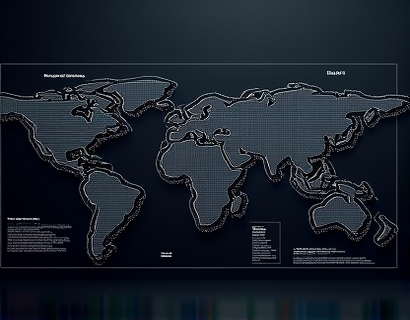Maximizing Multi-Chain Token Management: A Complete Guide for Blockchain Optimization and Performance
In the rapidly evolving world of blockchain technology, the management of tokens across multiple chains has become a critical aspect for blockchain professionals and token managers. As the landscape diversifies, understanding how to optimize and manage tokens effectively is essential for maximizing performance and ensuring seamless operations. This comprehensive guide aims to provide essential tools and strategies for efficient multi-chain token management, focusing on blockchain optimization and performance enhancement.
Understanding Multi-Chain Environments
Multi-chain environments refer to the existence of multiple blockchain networks that can operate independently or interact with one another. Each blockchain may have its unique features, consensus mechanisms, and token standards. The rise of multi-chain ecosystems has been driven by the need for scalability, interoperability, and specialized functionalities that different blockchains offer. For token managers, navigating this complex landscape requires a solid understanding of the various chains and their respective ecosystems.
The Importance of Token Management
Effective token management is crucial for several reasons. Firstly, it ensures that tokens are utilized efficiently, maximizing their potential value. Secondly, it helps in tracking performance metrics, which are vital for making informed decisions. Lastly, proper management can mitigate risks associated with volatility and security vulnerabilities. Token managers must adopt a proactive approach to manage their assets across different chains, ensuring that they are not only compliant with regulations but also optimized for performance.
Key Strategies for Multi-Chain Token Management
1. Comprehensive Asset Tracking
One of the first steps in effective multi-chain token management is comprehensive asset tracking. This involves maintaining an up-to-date inventory of all tokens held across various blockchains. Utilizing blockchain explorers and asset management tools can facilitate this process, allowing token managers to monitor balances, transaction histories, and token performance metrics in real-time.
2. Leveraging Interoperability Solutions
Interoperability solutions play a vital role in multi-chain environments. These solutions enable different blockchains to communicate and interact with one another, allowing for seamless token transfers and exchanges. Token managers should explore options such as cross-chain bridges and atomic swaps to enhance liquidity and facilitate transactions across chains.
3. Utilizing Smart Contracts
Smart contracts are self-executing contracts with the terms of the agreement directly written into code. They can automate various processes, such as token transfers, compliance checks, and performance tracking. By leveraging smart contracts, token managers can reduce manual intervention, minimize errors, and enhance operational efficiency.
4. Implementing Risk Management Strategies
Risk management is a critical component of token management. Token managers should identify potential risks associated with each blockchain, including security vulnerabilities, regulatory changes, and market volatility. Implementing strategies such as diversification, insurance, and regular audits can help mitigate these risks and protect assets.
5. Performance Analysis and Optimization
Regular performance analysis is essential for optimizing token management. Token managers should establish key performance indicators (KPIs) to evaluate the success of their strategies. Metrics such as transaction speed, cost efficiency, and user engagement can provide valuable insights into performance. Utilizing analytics tools can help in gathering and interpreting this data, enabling informed decision-making.
Essential Tools for Multi-Chain Token Management
1. Wallet Solutions
Choosing the right wallet solution is fundamental for managing tokens across multiple chains. Multi-currency wallets that support various blockchain networks allow token managers to store, send, and receive tokens seamlessly. It is essential to select wallets that prioritize security, user experience, and compatibility with different chains.
2. Analytics Platforms
Analytics platforms provide valuable insights into token performance and market trends. These tools can help token managers track price movements, trading volumes, and other relevant metrics. By leveraging analytics, managers can make data-driven decisions to optimize their token strategies.
3. Portfolio Management Tools
Portfolio management tools enable token managers to oversee their entire asset portfolio in one place. These tools can provide real-time updates on asset values, performance metrics, and diversification strategies. By utilizing portfolio management tools, token managers can streamline their operations and enhance their decision-making processes.
4. Security Solutions
Security is paramount in the blockchain space. Token managers should invest in robust security solutions, including hardware wallets, multi-signature wallets, and security audits. These measures can help protect assets from hacks, theft, and other security threats.
Best Practices for Multi-Chain Token Management
1. Stay Informed About Market Trends
The blockchain landscape is constantly changing, with new projects, regulations, and technologies emerging regularly. Token managers should stay informed about market trends and developments to adapt their strategies accordingly. Following industry news, participating in forums, and attending conferences can provide valuable insights.
2. Foster Community Engagement
Engaging with the community is essential for token managers. Building relationships with other professionals, developers, and users can provide valuable feedback and insights. Community engagement can also enhance the visibility and adoption of tokens, contributing to their overall success.
3. Regularly Review and Update Strategies
Token management strategies should not be static. Regularly reviewing and updating strategies based on performance metrics and market conditions is crucial for long-term success. Token managers should be flexible and willing to adapt their approaches as needed.
4. Focus on User Experience
User experience plays a significant role in the success of tokens. Token managers should prioritize creating a seamless and user-friendly experience for token holders. This includes providing clear information, easy access to services, and responsive support.
Challenges in Multi-Chain Token Management
1. Complexity of Interactions
Managing tokens across multiple chains can be complex due to the different protocols, standards, and functionalities of each blockchain. Token managers must navigate these complexities to ensure efficient operations and avoid potential pitfalls.
2. Regulatory Compliance
Regulatory compliance is a significant challenge in the blockchain space. Token managers must stay informed about the legal requirements in different jurisdictions and ensure that their operations comply with relevant regulations. This may involve working with legal experts to navigate the evolving regulatory landscape.
3. Security Risks
The decentralized nature of blockchain technology presents unique security challenges. Token managers must be vigilant in protecting their assets from hacks, scams, and other security threats. Implementing robust security measures and staying informed about potential vulnerabilities is essential.
Future Trends in Multi-Chain Token Management
1. Increased Interoperability
The future of multi-chain token management will likely see increased interoperability between different blockchains. As more projects focus on creating solutions that enable seamless communication between chains, token managers will benefit from enhanced liquidity and operational efficiency.
2. Enhanced Security Protocols
As the blockchain space matures, security protocols are expected to evolve. Token managers can anticipate the development of more sophisticated security measures, including advanced encryption techniques and decentralized identity solutions, to protect assets and enhance trust.
3. Growing Adoption of Decentralized Finance (DeFi)
The rise of decentralized finance (DeFi) is transforming the way tokens are managed and utilized. Token managers should explore opportunities within the DeFi space, including lending, borrowing, and yield farming, to maximize the potential of their assets.
4. Integration of Artificial Intelligence
Artificial intelligence (AI) is poised to play a significant role in the future of token management. AI-driven analytics and decision-making tools can provide token managers with valuable insights and automate various processes, enhancing efficiency and performance.
Conclusion
Maximizing multi-chain token management is essential for blockchain professionals and token managers looking to optimize performance and ensure efficient operations. By understanding the complexities of multi-chain environments, implementing effective strategies, and utilizing essential tools, token managers can navigate the evolving landscape with confidence. As the blockchain space continues to grow and evolve, staying informed about trends and best practices will be crucial for long-term success. Embracing innovation and adapting to changes will empower token managers to thrive in the dynamic world of blockchain technology.










































